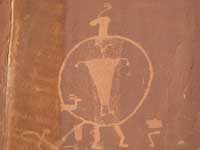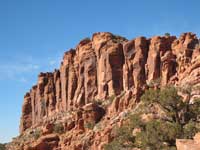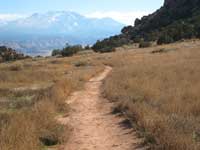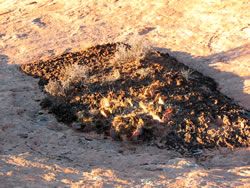HIKING HAPPENINGS March 2011
Hidden Valley – An Ancient Hangout
article and photos by Marcy Hafner
 The extensive display of rock art etched on the Navajo Sandstone walls in Hidden Valley is a strong clue that a lot of activity occurred here a long, long time ago. Evidence of habitation and heavy foot traffic would also suggest that this valley was used as a social and ritual center - a popular gathering place, a local hangout for the prehistoric Basketmaker people. The extensive display of rock art etched on the Navajo Sandstone walls in Hidden Valley is a strong clue that a lot of activity occurred here a long, long time ago. Evidence of habitation and heavy foot traffic would also suggest that this valley was used as a social and ritual center - a popular gathering place, a local hangout for the prehistoric Basketmaker people.
Some historians believe that 25,000 years ago, during the last Pleistocene Ice Age, a human migration took place over The Bering Land Bridge – a passage between Alaska and Siberia that existed during that time. It is well established that a major migration did occur 12,000 to 15,000 years ago when humanity spread rapidly throughout North, Central and South America.
The first evidence of a prehistoric people in southeast Utah can be traced back to around 6,000 B. C. Constantly on the move, these bands of hunter/gatherers were known as the Desert Archaic (sometimes referred to as Barrier Canyon). These nomads left little behind of their legacy except for the rock images they pecked and painted on the sandstone canyon walls.
The Basketmakers replaced or evolved from the Archaic around 0 A.D. During their domain, which only lasted 800 to 900 years, they were prolific artists and the majority of rock art that still exists in Hidden Valley is associated with these people. Unlike their predecessors, the Basketmakers became a semi-agrarian society. Over an extended period of time their culture gradually transformed into the era of the modified Basketmakers, and they settled down to build their pithouses over shallow excavations in the ground. As farmers, they lived in small clans tending their fields of squash and corn - the granaries for the storage of their corn still exist today. Agriculture, however, did not meet all their dietary needs and the hunter/gatherer tradition continued, with the more efficient bow and arrow slowly replacing the atlatl.
Over time they perfected the craft of weaving willow rods, yucca fibers and human hair into functional baskets. When they mastered the technique of tightly weaving the fibers to make their containers waterproof, their lives changed dramatically. Now they could drop hot stones into the water until it boiled. Just imagine a menu that now included the nourishing meals of soup and stew!!
To get to the Hidden Valley Trailhead, from Center and Main Street drive south on Highway 191 three and a half miles. At the stucco dental office building turn right on to Angel Rock Road and drive several blocks until it dead ends. Then turn right on to Rimrock Road and continue the short distance to the trailhead.
From the parking area it is puzzling as to where Hidden Valley must be sequestered; broken rocky cliffs keep it hidden from view. A daunting series of switchbacks – a definite bike carry route - snake their way 680 vertical feet up the steep rubbly trail to the 1.3 mile length of the valley, which is bordered on the southwest by massive Wingate Sandstone cliffs.
 After my successful navigation through the jumping jack, big-rock obstacle course to the top, I plop down for a “grateful that my body is still intact” break! Relaxing on my high-ended platform, I savor the bird’s-eye view and pick out so much that is familiar – Spanish Trail Arena, Highway 191, White’s Ranch, Spanish Valley Drive, the Moab Golf Course and the OK RV Park. Beyond the greenness of Spanish Valley, my searching gaze lingers on the entire range of the La Sal Mountains – a haunting white-mantled profile on the southeast horizon. After my successful navigation through the jumping jack, big-rock obstacle course to the top, I plop down for a “grateful that my body is still intact” break! Relaxing on my high-ended platform, I savor the bird’s-eye view and pick out so much that is familiar – Spanish Trail Arena, Highway 191, White’s Ranch, Spanish Valley Drive, the Moab Golf Course and the OK RV Park. Beyond the greenness of Spanish Valley, my searching gaze lingers on the entire range of the La Sal Mountains – a haunting white-mantled profile on the southeast horizon.
Finally getting up, I move along behind the rim on a short uphill section into a forest of pygmy-sized junipers where the trail passes the boundary of Behind The Rocks Wilderness Study Area. On the gentle decline, the entire brushy, grassy bottom of Hidden Valley stretches ahead with a wide level dirt path that is so easy on the feet, the knees and the lungs!
Now I intently listen for the “chuk-chuk-chuk” alarm call of the chukar, an upland game bird that was introduced to the intermountain west from the Middle East. These chicken-sized ground dwellers, which are the national bird of Pakistan, thrive on rocky hillsides with a good supply of grassy vegetation, and Hidden Valley obviously appeals to them.
When disturbed, these skittish birds prefer to run uphill, but when their cover is completely blown, they take off in a frenzied short distance whirl of wings. I seldom get a close-up look at these flighty birds, but sometimes, on a lucky day they’ll hold tight long enough for an in depth observation of their distinctive markings - the bright red bill and legs and the white throat that is decorated with a black necklace. On an extremely lucky day I’ll even experience that rare opportunity to watch the parents with their young, who are able to leave the nest shortly after hatching. The most bizarre episode occurred as I was driving down Rimrock Road – feeling like a sheep dog, I herded the adults and youngsters in front of me until it finally dawns on this confused and frazzled flock to get off the road!!
 At an obvious hump in the trail, which quickly drops down to join the Moab Rim Jeep Trail, the horizon suddenly opens up to an expansive view of Poison Spider Mesa, Island In The Sky and a huge series of fins and cliffs that rise above the Colorado River. At the top of this mini-pass, I take a right to follow a distinctive footpath, which leads to a south facing Navajo Sandstone wall with a huge gallery of fascinating petroglyphs that have been on display for over a thousand years. At an obvious hump in the trail, which quickly drops down to join the Moab Rim Jeep Trail, the horizon suddenly opens up to an expansive view of Poison Spider Mesa, Island In The Sky and a huge series of fins and cliffs that rise above the Colorado River. At the top of this mini-pass, I take a right to follow a distinctive footpath, which leads to a south facing Navajo Sandstone wall with a huge gallery of fascinating petroglyphs that have been on display for over a thousand years.
These imaginative panels overflow with the creative figures of deer, animal tracks, odd shaped human figures (some with big ears,) long lines of hand holders, tribal head dresses, hand and foot impressions, necklaces, symmetrical lines and dots, big cat-like depictions – as well as plenty of bighorn sheep, which were undoubtedly a major food source in their lives.
In the summer, shade on the Hidden Valley Trail departs in a hurry very early in the morning and it heats up fast. Ironically, in the winter the rim blocks the rays of the low hanging sun for most of the day. Consequently when it snows, it becomes a treacherous slide-on-ice walk, which I avoid.
This close-to-town four mile round trip exploration is ideal in the spring and fall when you can comfortably enjoy its prehistoric past. During your outing, you can linger for a contemplation of the significance and meaning of all this rock art that has survived for centuries within its protective walls. I always wonder what the objective could possibly have been for all these glyphs - Creative story telling? Cultural and spiritual expression? A depiction of their daily activities? A recording of visions? Or just an artistic outlet? The answers are buried with the ancient artists.
|
Biological Soil Crust (aka)
Cryptos (krip’ tose):
The surface of
Moab’s desert is held
together by a thin skin of living organisms known as cryptobiotic
soil or cryptos. It has a lumpy black appearance, is very
fragile, and takes decades to heal when it has been damaged.
This soil is a critical part of the survival of the desert.
The cryptobiotic organisms help to stabilize the soil, hold
moisture, and provide protection for germination of the seeds
of other plants. Without it the dry areas of the west would
be much different. Although some disturbance is normal and
helps the soil to capture moisture, excessive disturbance
by hooves, bicycle tires and hiking boots has been shown
to destroy the cryptobiotic organisms and their contribution
to the soil. When you walk around Moab avoid crushing the
cryptos. Stay on trails, walk in washes, hop from stone to
stone. Whatever it takes, don’t crunch the cryptos
unless you absolutely have to! |

Cryptobiotic soil garden
|
|
|